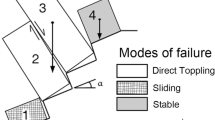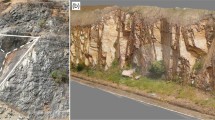Abstract
This article presents a summary of the research on the novel tortuous surface method to stochastically analyze the stability of two-dimensional bimslopes, which are slopes composed of bimrocks or bimsoils. Tortuous failure surfaces (TFSs) are slip surfaces that develop around blocks when bimslopes fail. The method was automated through an algorithm that locates a slip surface passing around the blocks as if it were the solution of a “maze puzzle.” Slope stability analyses were performed using the limit equilibrium method (LEM). To compare many different models, the normalized factor of safety of a TFS (\(f_{\mathrm {n}}^{\ast }\)) was computed. \(f_{\mathrm {n}}^{\ast }\) is obtained by dividing the fs from the TFS by the fs from the surface potentially produced when there are no blocks (the critical circular surface or the matrix-only surface (MOS)). Two groups of analyses were performed. First, two tortuosity parameters, the tortuous length ratio (TLR) and the average tortuous width (ATW), were analyzed through the evaluation of a hypothetical slope of 10 m height and 35∘ inclination with varying block proportions. Second, similar hypothetical models were developed with three different values of the slope height, slope inclination, and ratio of the unit weight of the blocks to the unit weight of the matrix; then, the behavior of \(f_{\mathrm {n}}^{\ast }\) for different values of both the cohesion and friction angle of the matrix was presented in a sensitivity analysis. A prime conclusion of the research is that for prudent geotechnical design, stochastically based stability analyses of bimslopes are far preferable to deterministic analyses.








Similar content being viewed by others
References
Bishop A (1955) The use of the slip circle in the stability analysis of slopes. Gèotechnique 5 (1):7–17. https://doi.org/10.1680/geot.1955.5.1.7
Fredlund DG, Krahn J (1977) Comparison of slope stability methods of analysis. Canadian Geotechnical Journal 14(3):429–439. https://doi.org/10.1139/t77-045
GEO-SLOPE (2015) Stability Modeling with SLOPE/W. An Engineering Methodology. GEO-SLOPE International Ltd
Grigull S, Krohe A, Moos C, Wassmann S, Stockhert B (2012) Order from chaos: a field-based estimate on bulk rheology of tectonic mélanges formed in subduction zones. Tectonophysics 568-569:86–101. https://doi.org/10.1016/j.tecto.2011.11.004
Guerra C, Pinzón J (2015) Modelación numérica multiescala de Bimrocks para el análisis de estabilidad de taludes. Master’s thesis Pontificia Universidad Javeriana, Bogotá, Colombia
Guerra C, Pinzón J, Prada L, Ramos A (2016) Multiscale modelling of the slope stability of block-in-matrix materials. In: Proceedings: geo-chicago 2016: sustainable geoenvironmental systems, Chicago, Illinois, pp 658–667
Hart P, Nilsson N, Raphael B (1968) A formal basis for the heuristic determination of minimum cost path. IEEE Transactions of Systems Science and Cybernetics ssc-4(2):100–107. https://doi.org/10.1109/TSSC.1968.300136
Irfan TY, Tang KY (1993) Effect of the coarse fraction on the shear strength of colluvium. GEO Report No. 23 SPR 15/92 Geotechnical Engineering Office, Civil Engineering Department, Hong Kong
Khorasani E, Amini M, Hossaini MF, Medley E (2019a) Evaluating the effects of the inclinations of rock blocks on the stability of bimrock slopes. Geomechanics and Engineering 17(3):279–285. https://doi.org/10.12989/gae.2019.17.3.279
Khorasani E, Amini M, Hossaini MF, Medley E (2019b) Statistical analysis of bimslope stability using physical and numerical models. Eng Geol 254:13–24. https://doi.org/10.1016/j.enggeo.2019.03.023
Lindquist E (1994a) The strength and deformation properties of melange. Ph.d. thesis University of California, Berkeley, CA
Lindquist E (1994b) The strength and deformation properties of melange. PhD thesis University of Californa at Berkeley, Berkeley, California
Medley E (1994) The engineering characterization of melanges and similar block-in-matrix rocks (bimrocks). Ph.d. thesis University of California, Berkeley, CA
Medley E (2001) Orderly characterization of chaotic franciscan melanges. Felsbau Rock and Soil Engineering – Journal for Engineering Geology. Geomechanics and Tunneling 19(4):35–43
Medley E (2004) Observations on tortuous failure surfaces. Felsbau Rock and Soil Engineering – Journal for Engineering Geology, Geomechanics and Tunneling 22(5):35–43
Medley EW, Lindquist E (1995) The engineering significance of the scale-independence of some franciscan melanges in california, usa. In: Rock Mechanics Proceedings of the 35th U.S. Symposium
Medley EW, Sanz PF (2004) Characterization of bimrocks (rock/soil mixtures) with application to slope stability problems. In: proceedings: EUROCK 2004 & 53rd Geomechanics Colloquy, Salzburg, Austria
Medley EW, Zekkos D (2011) Geopractitioner approaches to working with antisocial mélanges. Geol. Soc. Am. Spec. Pap. 480:261–277
Minuto D, Morandi L (2015) Engineering Geology for Society and Territory, vol 2: Landslide Processes, Springer International Publishing, chap 192: Geotechnical characterization and slope stability of a relict landslide in bimsoils (blocks in matrix soils) in dowtown Genoa, Italy, pp 1083–1088. https://doi.org/10.1007/978-3-319-09057-3_192
Montoya-Araque EA, Suarez-Burgoa LO (2018) Pybimstab: Application software for 2d slope stability analysis of block-in-matrix and homogeneous materials. SoftwareX 7:383–387. https://doi.org/10.1016/j.softx.2018.11.003
Montoya-Araque EA, Suarez-Burgoa LO (2019) Automatic generation of tortuous failure surfaces in block-in-matrix materials for 2d slope stability assessments. Computers & Geotechnics 12:17–22. https://doi.org/10.1016/j.compgeo.2019.04.002
Morgenstern NR, Price VE (1965) The analysis of the stability of general slip surfaces. Géotechnique 15(1):79–93. https://doi.org/10.1680/geot.1965.15.1.79
Napoli ML, Barbero M, Ravera E, Scavia C (2018) A stochastic approach to slope stability analysis in bimrocks. International Journal of Rock Mechanics and Mining Sciences 101:41–49. https://doi.org/10.1016/j.ijrmms.2017.11.009
Napoli ML, Barbero M, Scavia C (2019) Slope stability in heterogeneous rock masses with a block-in-matrix fabric. In: Rock mechanics for natural resources and infrastructure development, Foz do Iguassu, Brazil, pp 3482–3488
Raymond LA (1984) Melanges: their nature, origin and significance. Tech. Rep. 198 Geological Society of America Special Papers, Boulder, Colorado
Spencer E (1967) A method of analysis of the stability of embankments assuming parallel inter-slice forces. Géotechnique 17(1):11–26. https://doi.org/10.1680/geot.1967.17.1.11
Suarez-Burgoa LO, Ariza-Triana A, Montoya-Araque EA (2019) Modelamiento de estructuras de bimsoils mediante el empaquetado de partículas circulares en \(\mathbb {R}^{2}\). Revista de la Facultad de Ciencias 8(2):116–138. 10.15446/rev.fac.cienc.v8n2.72343
Acknowledgments
Special thanks to Universidad Nacional de Colombia and the “young researchers” program from Departamento Administrativo de Ciencia, Tecnología e Innovación –COLCIENCIAS–.
Author information
Authors and Affiliations
Corresponding author
Ethics declarations
Conflict of interest
The authors declare that they have no conflict of interest.
Rights and permissions
About this article
Cite this article
Montoya-Araque, E.A., Suarez-Burgoa, L.O. & Medley, E.W. Application of the tortuous surface method to stochastic analysis of bimslope stability. Bull Eng Geol Environ 79, 5329–5340 (2020). https://doi.org/10.1007/s10064-020-01909-5
Received:
Accepted:
Published:
Issue Date:
DOI: https://doi.org/10.1007/s10064-020-01909-5




